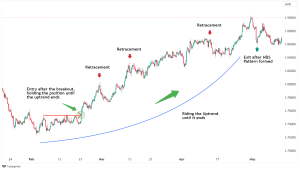Top 5 Trading Strategies for Consistent Profits
Introduction
In the world of trading, having a strategy is crucial for success. A well-defined strategy helps traders make informed decisions and increases the chances of consistent profits. But with so many strategies out there, which ones should you consider? In this post, we’ll explore the top 5 trading strategies that can help you achieve consistent profits, whether you’re a beginner or an experienced trader.
1. Day Trading
Overview: Day trading involves buying and selling financial instruments within the same trading day. The goal is to capitalize on small price movements, often using leverage to increase potential returns.
- How It Works: Day traders typically use technical analysis and real-time data to make quick decisions. They focus on high-liquidity assets and aim to close all positions before the market closes to avoid overnight risk.
- Pros: Potential for high returns in a short time; no overnight exposure to market risk.
- Cons: Requires significant time and attention; high risk due to frequent trades.
- Best For: Traders who can dedicate time to closely monitoring the markets and are comfortable with a fast-paced trading environment.
2. Swing Trading
Overview: Swing trading aims to capture gains over a few days to several weeks. Traders look for “swings” in the market—short-term trends or patterns—and enter trades to take advantage of these movements.
- How It Works: Swing traders use a combination of technical and fundamental analysis to identify entry and exit points. They often hold positions overnight, making them vulnerable to market gaps but also allowing for larger price moves.
- Pros: Less time-intensive than day trading; allows traders to capture larger price movements.
- Cons: Exposure to overnight market risks; requires patience to hold positions.
- Best For: Traders who prefer a slower pace than day trading and are comfortable holding positions for several days or weeks.
3. Position Trading
Overview: Position trading is a long-term strategy where traders hold positions for weeks, months, or even years. This strategy focuses on the overall trend rather than short-term fluctuations.
- How It Works: Position traders rely heavily on fundamental analysis, such as economic indicators and company earnings, to make their decisions. They aim to capitalize on major price movements by holding onto their positions until they reach their target.
- Pros: Less stress and time commitment; potential for substantial gains over time.
- Cons: Long-term exposure to market risk; requires strong conviction in your analysis.
- Best For: Traders with a long-term perspective and a willingness to hold positions through market fluctuations.
4. Scalping
Overview: Scalping is a high-frequency trading strategy where traders aim to make numerous small profits throughout the day. The idea is to “scalp” small price changes, often holding positions for just seconds or minutes.
- How It Works: Scalpers use technical analysis and high-speed trading platforms to execute trades quickly. They focus on assets with high liquidity and narrow spreads to ensure rapid execution.
- Pros: Potential for consistent, small gains; low exposure to market risk due to quick trades.
- Cons: High transaction costs due to frequent trading; requires advanced knowledge and tools.
- Best For: Experienced traders with access to sophisticated trading technology and a deep understanding of the markets.
5. Trend Following
Overview: Trend following is a strategy that involves identifying and trading in the direction of a market trend. The idea is to “ride the trend” until it shows signs of reversal.
- How It Works: Trend followers use indicators like moving averages, trendlines, and momentum indicators to identify trends. They enter trades in the direction of the trend and hold their position until the trend weakens or reverses.
- Pros: Can generate significant profits during strong trends; relatively simple to implement.
- Cons: Can result in losses during choppy or sideways markets; requires discipline to avoid early exits.
- Best For: Traders who prefer a systematic approach and are comfortable holding positions for extended periods.
Conclusion
Choosing the right trading strategy depends on your individual goals, risk tolerance, and time commitment. Whether you’re interested in the fast-paced world of day trading or the more patient approach of position trading, these strategies offer a starting point for consistent profits. The key to success is to understand each strategy thoroughly, practice it in a demo account, and stick to your trading plan.











Post Comment